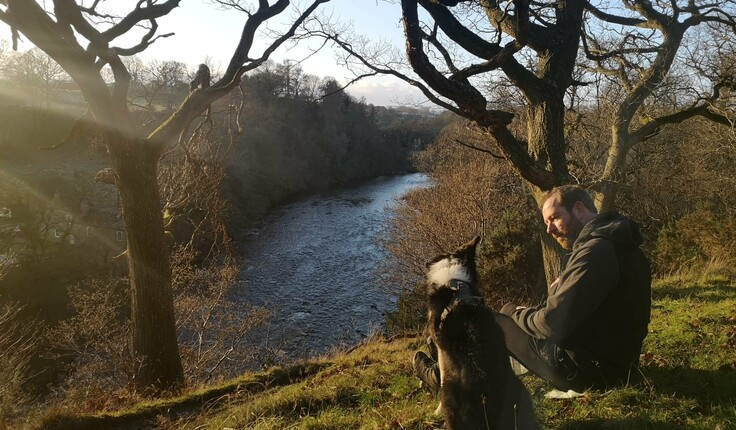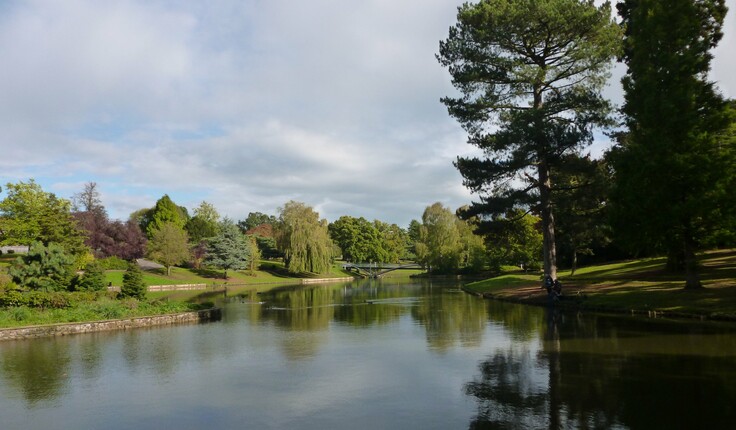News
Britain's cultural landscapes
Posted 26 07 2022
in News

Video now available to view
Chris Mayes is a UK landscape architect who has worked in both private practice and public service, helping to realise the value of some of Britain’s most precious cultural landscapes.
On Friday 22 July 2022 Chris presented an NZILA webinar: A Tudor palace garden to world heritage sites. The video of the webinar is available to view at the end of this article and in the CPD section of the website.
LAA caught up with Chris ahead of the event. He says the webinar reflects on his career so far “exploring some of my thinking about cultural landscapes, what they are, how I assess them, and what can be done to help conserve them.”
In the following Q & A he told us more about his work and the landscape architecture profession generally.
LAA: Currently you work as a landscape architect looking at heritage at risk for Historic England, how do you best describe this role?
CM: Historic England is the body that advises the UK government on the conservation and management of heritage in England. In English law heritage assets can be identified for their interest to the nation and thereby afforded a degree of protection. Buildings and structures are recorded on a statutory list. There are currently around half a million listed buildings and structures in England ranging from palaces to milestones and phone boxes. Archaeological features, earthworks, ruined structures and industrial remains for example, are also identified and recorded as scheduled monuments. We also maintain a list of historic battlefields across the country and in the marine environment, shipwrecks.
A large part of my role is to advise on the management and conservation of another type of heritage asset; registered parks and gardens of special historic interest. These are designed landscapes that are at least 30 years old, that are of national importance. Unlike the many thousands of buildings and structures of historic importance there are just short of 1700 registered designed landscapes across the country, and just over 300 in the north of England where I’m based. Registered designed landscapes vary in nature from the classic English country house landscapes of ‘Capability’ Brown and Humphrey Repton, to public parks and cemeteries and even, in my patch, a 20th century industrial site (designed by Dan Kiley, the American landscape architect, for the Cummins diesel engines company). Generally, though I provide advice and assess the significance of landscape affecting any heritage asset when called on to do so.
Many historic landscapes are well looked after under the guardianship of benevolent private landowners, public bodies and municipal authorities. However, a significant number of sites suffer from neglect, divided ownership, lack of investment and development pressures. Where these factors threaten the significance and value of the landscape it is my role to negotiate a positive solution to the threat or reverse the harm done. Threats can also come in more challenging forms, such as environmental threats – climate change and pests and diseases – or antisocial behaviour and vandalism; these challenges are a little more tricky to negotiate.
In order to navigate a route to the positive conservation of a designed landscape I first have to articulate what is significant about the site; the historical, aesthetic and communal values, and evidence of past human activities and tastes that it possesses. Being able to unpick the story of a landscape and communicate that to current generations enables us to hand over these assets to future generations in the best possible condition. It doesn’t matter whether a place is 500 years old or it is just 30 years since it was created, the same process and approach is applicable. My role is to analyse what is valued, by who and how we conserve that value for the future.
LAA: Can you describe a typical day?
CM: To put it simply, one of the great pleasures of my job is no day is ‘typical’. Even taking the core of my work the sites I’m involved with are so varied that no two days seem the same. Last week I was visiting a garden landscape that only survives as earthworks, but probably has its origins in the early 17th century. Next week I will be continuing a five year journey helping a local community group take action to restore and manage their local public park that was designed and laid out in the 1860s. And in between I’ve been assessing and advising on the potential impacts of a large industrial development adjacent to an 18th century parkland.
But my role isn’t simply about working with landscapes from the past. We are currently running a programme of grant funded activities to help regenerate the ‘high street’ in towns across the country. Many historic high streets are not seen as immediately compatible with current retail trends and have become divorced from the communities that historically supported or depended on them. Shops are considered too small, pavements too narrow and roads are congested with cars. However, looking at the historical development of the townscape and refreshing the way the high street is presented with contemporary interventions seen through the lens of cultural heritage can breathe new life into them. So, drawing on a palette of historically-inspired materials and working with the grain of a historic high street I am able to advise local authorities and partners on how best to implement contemporary street and public realm enhancements. Drawing on the past almost always enhances a contemporary scheme of intervention.
In addition, my work often crosses over into the ‘natural’ environment. In the UK we have two further landscape designations that are also defined, in part, by cultural heritage; National Parks and Areas of Outstanding Natural Beauty. These designations are overseen by our ‘sister’ organisation, Natural England, but there are many areas where heritage is a defining component of the landscape. Most notably for me is the work I do with our partners in the English Lake District; both a National Park and a UNESCO World Heritage Site.
So a ‘typical’ day can take me from having a conversation with a concerned resident about the condition of their local Victorian cemetery to discussing the implications of government policy on the management of a World Heritage Site.
LAA: We in NZ imagine heritage areas in the UK are well protected, preserved and prioritised - is this the case?
CM: As I’ve mentioned previously, we have a long tradition of heritage protection and conservation. Some of our heritage sites are known throughout the world; think St Paul’s Cathedral, Stone Henge or Stourhead Park. Technically the highly prominent heritage assets are afforded no greater protection than any other listed, scheduled or registered building, monument or landscape. However, the reality is that economic and development pressures, and neglect and inappropriate management can affect all and any heritage assets. The level of protection heritage gets is dependent on understanding both what is important about an asset and the nuances of statute and planning policy.

Certainly with regard to listed buildings and scheduled monuments, the protection system can be extremely effective. For example, we have a dedicated ‘heritage crime’ unit, which works closely with local police forces around the country to bring prosecution for damage to buildings and monuments. This is usually related to the theft of material or illegal digging of archaeological sites in pursuit of ‘treasure’.
Pressure on heritage also comes from development and redevelopment. UK planning policy sets a high bar on the loss of heritage to development. But heritage is far from sacrosanct, and even where substantial harm to and total loss of heritage would generally be considered unacceptable this can be outweighed by perceived public benefits. In short, it’s rare for the presence of a heritage asset to result in the refusal of planning permission and more common that we negotiate a constructive compromise.
LAA: Much of your work is around cultural landscapes - can you elaborate on your work in this area?
CM: The UK has a long tradition of heritage protection. In fact the Society for the Protection of Ancient Buildings (SPAB) was founded in 1877 by William Morris in response to over-enthusiastic, harmful ‘restorations’ of churches. Since then the protection of material culture enshrined in our built heritage has slowly been incorporated into legislation and planning practice. Perhaps less well-known is that the movement to protect our cultural landscapes – places where the interaction between people and nature are uniquely expressed – had its origins nearly a century before this. The most prominent example of this can be seen in the history of the English Lake District.
The Romantic poet, William Wordsworth settled in the Lake District in 1799, retreating from the increasing industrialisation of towns and cities and lowland agriculture in England. He found a muse for his writings in what he saw as a harmonious relationship between farming and nature in the Lake District; a system that had existed for centuries and was difficult to pollute with the influences of ‘improvement’. A desire to protect this landscape from the ravishes of ‘modernity’ lead to the establishment of the western conservation movement, and ultimately the foundation of the National Trust; a model of charitable property ownership for the benefit of the national that has been replicated around the world. The English Lake District is now inscribed on the World Heritage List as a cultural landscape, and I have the privilege of playing a small role in its management.
My work is defined by understanding the relationship between people and place – the establishment of cultural behaviour that is intrinsically linked to the underlying natural environment. Human endeavours to sustain themselves, develop, benefit and event exploit the environment inevitably leave a legacy. That combination of natural resources and human activity results in a unique and distinctive place; a cultural landscape. Whether it’s an aesthetically pleasing garden accompanying a country house, and industrial landscape, an agricultural landscape or a military or administrative feature we can make improvement to our and future generations lives by understanding, managing and conserving.
LAA: You are interested in better understanding the role of landscape architects here in NZ regarding cultural landscapes - why?
CM: Some of the landscapes that I work in here in England, I can read the pattern of human influence as originating as far back as 6,000 years ago. While there were ‘revolutionary’ cultural influences on the landscape – Roman occupation, Viking invasions, the Norman conquest, and even the agricultural revolution of the 18th century – there is a degree of continuity that has persisted and as such the cultural landscapes of England have more correctly ‘evolved’. I know how to read that narrative
While the physical structure and geography of the New Zealand landscape is somehow familiar, it is at the same time completely alien to me. Similarly, while I’ve read a little of Māori history and tradition, and the story and impact of settlers from the northern hemisphere, it is not a history that I have experienced directly. For me cultural landscapes can only be properly understood through immersion; actually being in the landscape.
I was looking for some way of pushing myself professionally and exploring whether my understanding of cultural landscapes could be applicable with a different cultural heritage. And the historical connection between the UK and New Zealand made it a natural and obvious place to look.
Being on the other side of the planet, it makes it a little difficult to immerse myself in the landscape, to physically experience it. So I’m looking to my professional colleagues to help me gain some sort of understanding of the landscape using a common language and background. As I’ve alluded to, our contemporary interventions in the landscape, the new places we are creating, are informed by the past and will transition into the future, so even gaining an understanding of the motivation behind design studios in New Zealand will help me.
And ultimately I want to come over and experience the landscape first hand. Who wouldn’t…!
LAA: A general question now - is the landscape architecture profession well understood in the UK?
CM: More often than not when I tell people I’m a landscape architect they will ask for advice on pruning their roses or how to grow better vegetables. With a little explanation most people will understand there is a difference between a landscape architect and a gardener, but the profession is still predominantly viewed as ‘designers of green stuff’.
Within the construction industry the profession is better understood, but undervalued and on the whole ‘retro-fitted’ into the design process; design the buildings first, then ask a landscape architect to design the residual spaces. Certainly, climate change adaptation and the global biodiversity crisis is helping the standing of the profession.
However, as a landscape architect who specialises in understanding and using evidence from the past to inform today’s decisions to deliver a more sustainable future, there is very little recognition or understanding. We are a diverse profession, it’s no wonder people don’t always understand what we do…
Share
16 Dec
National hui on RMA reforms - register now

Your prompt response appreciated
Last Thursday we shared an update outlining the Government’s proposed replacement of the RMA and the significant implications these Bills …
10 Dec
Proposed replacement of the RMA: Planning Bill and Natural Environment Bill

A message from the Environmental Legislation Working Group
On Tuesday this week, the Government released proposed bills to replace the Resource Management Act 1991. Reform of our planning …
03 Dec
Newly Registered Landscape Architects 2025

Celebrating professional achievement across Aotearoa The 2025 Registration process is now nearing completion, and we are delighted to acknowledge the …
Events calendar
Full 2025 calendar